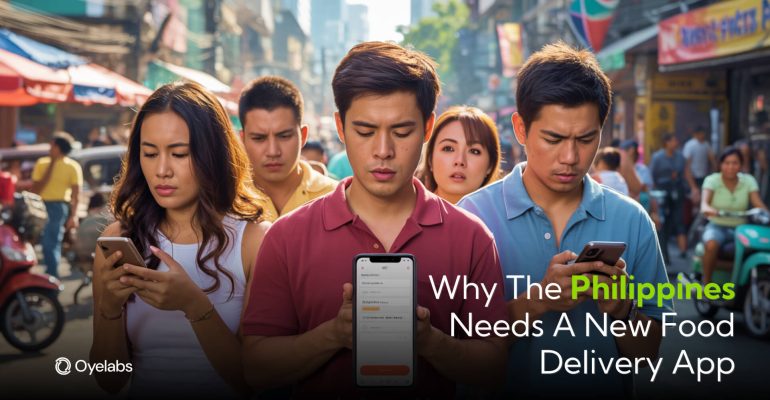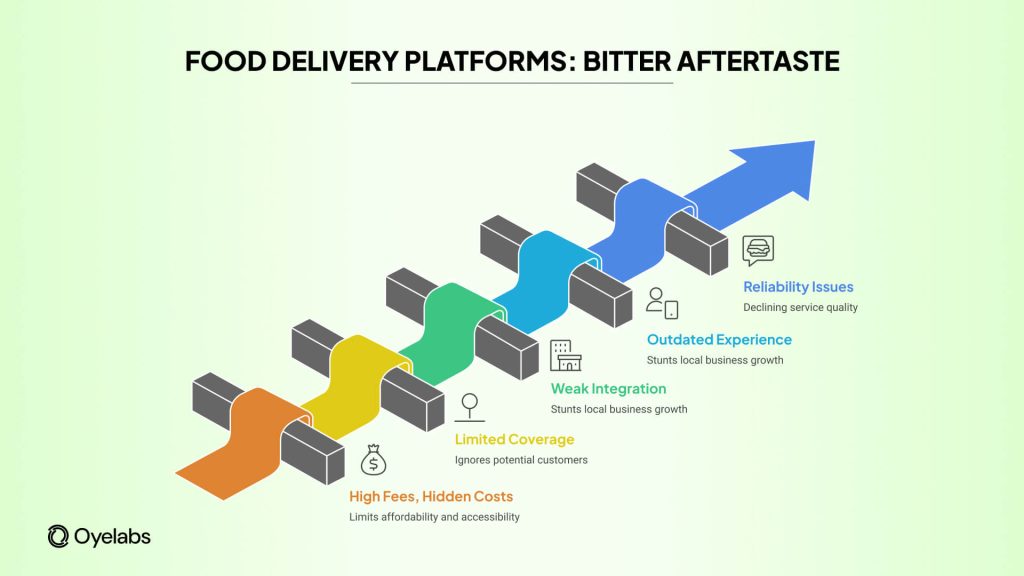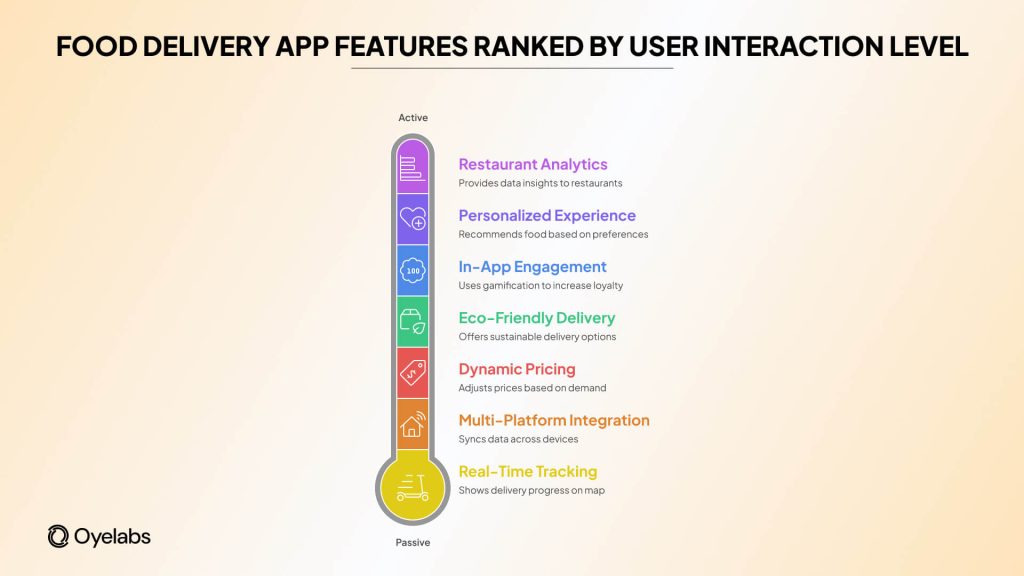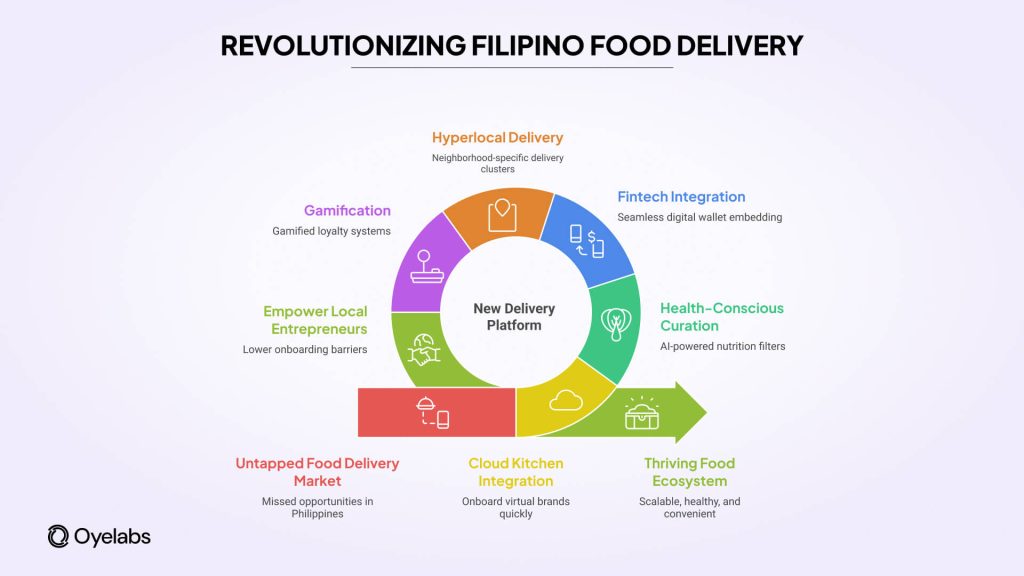Why Philippines Needs a New Food Delivery App like UberEats

Why Philippines Needs a New Food Delivery App like UberEats
Last Updated on August 28, 2025
“Another burger? Another fried chicken bucket? Come on, Philippines, we can do better.” That’s the kind of banter Gen Z users throw around while scrolling food delivery apps that all feel like clones of each other. The reality? The country’s food delivery market is booming, projected to hit billions in GMV, but the current players aren’t solving key pain points.
Think high delivery fees, poor hyperlocal coverage, lack of cloud-kitchen integration, and limited AI-powered personalization. Consumers are hungry (literally) for a smarter, fresher AI-integrated restaurant delivery platform like UberEats that combines real-time logistics, predictive demand analytics, and seamless user experience design.
Add in the Philippines’ mobile-first economy and its rising digital adoption, and the timing couldn’t be better. What’s missing is a new food delivery app built for 2025, one that speaks to both convenience-driven millennials and value-conscious Gen Z users.
The market’s appetite is huge; someone just needs to serve the right dish.
The Limitations of Existing Platforms
Let’s be honest: Filipinos love food, but when it comes to food delivery apps, the experience often leaves a bitter aftertaste. Here’s what’s really cooking.

High Delivery Fees and Hidden Costs
Filipino consumers are highly price-sensitive, yet existing food delivery platforms continue to burden them with steep delivery fees, surge pricing, and hidden costs. A recent Statista survey revealed that 67% of users in Southeast Asia abandon food delivery carts due to unexpected charges at checkout.
This mismatch between affordability and accessibility creates an equity gap, leaving middle- and lower-income households underserved. In technical terms, the lack of cost-optimization algorithms and dynamic pricing models limits scalability and adoption.
What’s needed is a platform that integrates AI-powered cost distribution to balance fair rider compensation with lower consumer pricing. Until then, affordability remains a barrier that prevents the sector from reaching its true potential.
Limited Hyperlocal Coverage
Manila may be swimming in food delivery options, but step into smaller cities or rural provinces, and suddenly the ecosystem dries up. Current players operate with centralized logistics models that simply don’t scale beyond urban hubs. This leaves millions of potential customers in Tier 2 and Tier 3 areas unserved.
According to World Bank data, over 47% of the Philippine population lives outside major metro regions, yet these areas are often ignored by legacy platforms. By not leveraging decentralized fleet management and hyperlocal routing algorithms, current apps are missing out on exponential growth.
The opportunity lies in building a delivery network that empowers local riders and micro-entrepreneurs while giving small-town consumers equal access to convenience.
As highlighted in Business Models for Food Delivery Apps like UberEats in 2025, hyperlocal delivery could unlock the next wave of growth by rethinking logistics at scale.
Weak Integration with Small Restaurants
Large QSR chains dominate current food delivery apps, overshadowing the vibrant ecosystem of small and mid-sized eateries. Independent restaurants, many of which represent authentic Filipino cuisine, face prohibitive onboarding fees, high commission rates, and poor app visibility. This structural issue limits customer variety while stunting local business growth.
Technically speaking, the lack of API-based merchant integration and scalable POS compatibility makes onboarding smaller restaurants cumbersome and inefficient. Data from the Philippine Statistics Authority shows SMEs make up 99% of businesses in the country, yet they remain underrepresented in food tech ecosystems.
A next-gen platform should democratize access by offering low-barrier digital onboarding, real-time inventory sync, and equitable commission structures, enabling small restaurants to thrive digitally.
Learning from how to attract restaurant partners to your food delivery app, platforms can create more sustainable ecosystems that support independent food businesses instead of sidelining them.
Outdated User Experience and Personalization
Food delivery apps are competing not just with one another but also with social media platforms where Gen Z and millennials spend hours daily. Yet many current platforms offer static UI designs, limited personalization, and clunky navigation.
Users want intuitive design, gamification, and AI-driven personalization engines that recommend meals based on order history, health preferences, or even mood indicators. A Nielsen study highlights that 74% of Gen Z users expect digital platforms to “know their preferences without asking.”
Existing apps lag behind by not investing in machine learning recommendation systems and real-time behavioral analytics. The result? User churn, reduced session times, and lack of loyalty. A platform that nails personalization could easily capture the next wave of digital-native consumers.
Forward-looking founders can draw lessons from Why Food Delivery Startups Fail – The Right App Saves You, which emphasizes how poor UX and personalization remain top reasons behind churn.
Reliability and Rider Management Issues
Filipino consumers often complain about late deliveries, missing items, or unresponsive customer service. Much of this stems from inefficient rider allocation algorithms and a lack of robust logistics orchestration systems.
Riders themselves face inconsistent pay structures and limited incentives, leading to high turnover rates and declining service quality. According to a Grab survey, 41% of customers cite delivery reliability as their top concern. The absence of predictive routing models, demand-forecasting engines, and real-time rider communication tools exacerbates the problem.
The need of the hour is a platform that prioritizes both consumer satisfaction and rider well-being, optimizing supply-demand balance while ensuring sustainable gig workforce practices.
Strategies explored in UberEats Business Model: How Does the App Make Money? demonstrate how rider management and incentive design play a direct role in platform reliability and profitability.
The Untapped Opportunity
Filipinos don’t just eat for hunger; they eat for culture, connection, and comfort. Yet the food delivery space still hasn’t unlocked its full flavor. Here’s where the real opportunities lie.

Cloud Kitchens and Virtual Brands
Cloud kitchens are quietly revolutionizing the food ecosystem. Unlike traditional restaurants, they’re low-overhead operations optimized for delivery. In the Philippines, where urban real estate costs are rising, cloud kitchens represent a scalable solution.
According to Euromonitor, the Asia-Pacific cloud kitchen market is projected to grow at a 15% CAGR through 2030, and the Philippines is ripe for adoption. Current food delivery apps barely scratch the surface in supporting virtual brands.
A new platform that integrates cloud-kitchen onboarding APIs, real-time order orchestration, and data-driven menu optimization could empower entrepreneurs to launch digital-first food brands quickly. The opportunity? Helping local cooks transform their signature dishes into scalable virtual franchises without the burden of expensive dine-in spaces.
This aligns closely with ideas discussed in Home Chefs in Your Food Delivery App – A Market Opportunity, which highlights how independent culinary talent can thrive through digital-first models.
Health-Conscious and Niche Segments
Filipinos are increasingly embracing healthier eating habits, from plant-based diets to calorie-counted meal plans. But most delivery platforms prioritize fast food giants over health-forward brands.
A 2024 Statista report noted that 27% of Filipino millennials actively seek healthier food options when ordering online. That’s a market segment begging for attention. The opportunity lies in curating AI-powered nutrition filters, health-tagged menus, and integration with fitness apps, so users can order meals aligned with their wellness goals.
With niche segments like vegan, gluten-free, or keto gaining traction, platforms that cater to specialized diets could build strong loyalty and attract premium-paying customers who value choice and transparency.
Integration with Fintech and Cashless Ecosystems
The Philippines is moving rapidly toward a cashless economy, with GCash and Maya boasting over 100 million combined users. Yet food delivery apps often lag in seamless fintech integration.
By embedding digital wallets, loyalty points, and buy-now-pay-later (BNPL) features directly into the food ordering experience, a platform could tap into a broader consumer base. Technical advantages like API-driven wallet sync, QR-code interoperability, and blockchain-enabled transaction security can also build trust and efficiency.
Given that 60% of Filipino consumers now prefer cashless over COD (Deloitte, 2024), there’s a golden opportunity to create a delivery app that doubles as a financial lifestyle hub.
As argued in How Subscription Models Are Changing the Food Delivery Market, fintech integration and recurring billing features can unlock new monetization streams for ambitious startups.
Hyperlocal Delivery Networks
One of the most untapped opportunities is hyperlocal delivery, bringing convenience to neighborhoods beyond the metro. Imagine micro-fulfillment hubs in Iloilo or Baguio powered by AI-driven route optimization and last-mile gig rider fleets.
Current platforms operate city-wide but miss out on geo-fenced, neighborhood-specific delivery clusters that could ensure faster service and lower costs. With over 47% of Filipinos living outside urban hubs (World Bank), there’s a massive demand in provinces where delivery apps are scarce.
A next-gen platform that embraces hyperlocal logistics can not only scale faster but also build stronger community engagement by supporting local riders and SMEs.
Gamification and Loyalty Ecosystems
Filipinos love rewards, and gamification is a proven growth lever. Current apps offer basic promo codes, but the real opportunity lies in gamified loyalty systems. Think streak rewards, leaderboard challenges, or coins redeemable for meals.
A Capgemini report showed that 72% of Gen Z users are more likely to stick with apps offering gamification features. By integrating AI-based engagement triggers, dynamic reward algorithms, and cross-platform loyalty integration, a food delivery app could boost retention and session time dramatically.
More than just discounts, gamification fosters emotional stickiness—turning ordering into a habit, not just a transaction.
Empowering Local Food Entrepreneurs
The Philippines has a rich culture of home-based cooks, street food vendors, and small eateries that rarely make it to mainstream apps. By lowering onboarding barriers and offering digital storefronts, micro-financing partnerships, and AI-driven pricing tools, a new platform could unlock this massive segment.
Data from the Department of Trade and Industry (DTI) shows that 99.5% of Philippine businesses are MSMEs, yet most lack digital presence. Capturing even a fraction of this untapped market could mean thousands of new vendors and millions in fresh GMV.
The opportunity is not just commercial; it’s cultural, allowing Filipino food traditions to scale digitally while strengthening community livelihoods.
Curious about different models to approach customer growth? Explore our guide on Types of Food Delivery Apps and the Secret to Their Success.
The Blueprint of a Next-Gen Food Delivery App
The food delivery game is evolving fast, and the winners will be the apps that think ahead. Let’s break down the blueprint of a truly next-gen food delivery app.

Hyper-Personalized User Experience
A next-gen food delivery app must go beyond generic listings. Think Netflix-style recommendations for food. Using AI-driven recommendation engines and machine learning algorithms, the app can understand user behavior, cuisine preferences, and even order timing.
For instance, if a user often orders sushi on Friday evenings, the app should surface the best sushi deals at 6 PM sharp. According to Accenture, 91% of consumers are more likely to shop with brands that recognize, remember, and provide relevant offers. Key personalization features include:
- Tailored dish and restaurant suggestions
- Adaptive search filters (vegan, keto, gluten-free)
- Time-sensitive recommendations (lunch rush, late-night bites)
Personalization boosts loyalty and average order value, making the app feel like a foodie companion, not just a delivery tool.
Real-Time Order Tracking with AR/VR
Basic GPS pins are outdated. Next-gen apps should embrace augmented reality (AR) and real-time logistics APIs. Imagine scanning your phone to see a 3D scooter icon moving through your city map, or visualizing estimated arrival in your living room with AR projections.
This interactive transparency builds trust. Data from Statista shows that 72% of customers expect real-time visibility into deliveries. To win credibility, apps must:
- Integrate live GPS and telematics
- Provide AR-based ETA visualization
- Offer push notifications at each delivery milestone
It’s not just delivery; it’s delivery made visible, engaging, and fun.
Seamless Multi-Platform Integration
A food delivery app shouldn’t live in isolation. Cross-platform functionality, web, iOS, Android, smartwatches, and even voice assistants, ensure maximum reach. Gen Z and millennials expect frictionless switching between devices, with saved carts and synced preferences intact.
Amazon’s success lies in this multi-device continuity. Features to prioritize:
- Smartwatch alerts for order updates
- Alexa/Google Assistant ordering
- Auto-sync across devices
By covering all digital touchpoints, the app becomes omnipresent, meeting customers wherever they are.
Dynamic Pricing & Surge Algorithms
Pricing isn’t static anymore. Using predictive analytics and surge models, apps can optimize revenue while balancing customer satisfaction. For instance, lower delivery fees during off-peak hours can boost orders, while higher fees during high demand protect operational margins. UberEats and DoorDash already use similar models.
According to McKinsey, dynamic pricing can lift margins by up to 25%. Core elements include:
- Real-time demand–supply mapping
- AI-driven surge multipliers
- Transparent pricing notifications
Done right, this boosts efficiency without alienating price-sensitive users.
Also read: How GrubHub Works
Eco-Friendly Delivery Models
Sustainability is no longer optional; it’s a customer expectation. Next-gen apps should integrate green logistics strategies like electric scooters, bicycle fleets, and eco-friendly packaging partnerships. A NielsenIQ study found that 78% of U.S. consumers value sustainable practices. Building eco-credibility can include:
- “Green delivery” filter options
- Carbon footprint tracking per order
- Discounts for choosing sustainable delivery modes
This isn’t just good branding; it aligns the platform with the growing eco-conscious movement, appealing especially to younger demographics.
In-App Engagement & Gamification
Food delivery doesn’t end at checkout. Gamification keeps users hooked. Features like reward points, streak bonuses, and surprise coupons drive retention. Starbucks’ gamified loyalty program is a prime example, contributing to 50% of its revenue. For food delivery apps, gamification can include:
- Spin the wheel for daily discounts
- Tier-based loyalty levels
- Social challenges like “Order with friends”
This turns routine food orders into engaging micro-experiences, ensuring repeat business.
Advanced Analytics Dashboard for Restaurants
A next-gen food delivery app isn’t just for users, it’s also a B2B growth engine for restaurants. Offering a robust analytics dashboard powered by big data and predictive analytics empowers restaurants to optimize menus, pricing, and inventory. Features include:
- Heatmaps of popular dishes
- Insights into peak ordering times
- Customer sentiment analysis through NLP (natural language processing)
For restaurants, data-driven decisions can mean 30% higher sales and reduced waste. For the platform, it builds stronger partnerships and a dependable ecosystem.
Also read: Top 10 Multi-Vendor Marketplaces Examples
Why Brands Trust Oyelabs for Food Tech Innovation
At Oyelabs, we specialize in building next-gen on-demand food ordering solutions that combine robust back-end architecture, scalable APIs, and AI-powered personalization engines. With proven expertise across 50+ global projects, our team ensures real-time order tracking, dynamic pricing algorithms, and cloud-native infrastructure for unmatched performance.
We follow agile methodology and leverage microservices-based architecture to future-proof your platform. Whether you’re a startup or an enterprise, Oyelabs delivers secure, high-availability systems designed to scale seamlessly.
If you want a platform that boosts customer retention and restaurant partnerships, choose Oyelabs, the trusted partner in digital food commerce innovation.
Conclusion
The Philippines’ food delivery market is booming, but most existing apps still struggle with high fees, inconsistent service, and limited personalization. With a young, mobile-first population and a growing demand for convenience, there’s a clear gap for a smarter, faster, and more customer-centric food delivery solution.
A next-gen app, built with AI-driven personalization, sustainable logistics, and seamless multi-platform integration, can redefine how Filipinos experience food on demand. The opportunity is wide open.
If you’re ready to build the Philippines’ next big food delivery success story, partner with Oyelabs and turn innovation into market leadership.




